Earned Capital Gains in FY 2022-23? Here’s the ITR Form Which Salaried Individuals Must Use
Mitali Dhoke
Jul 15, 2023 / Reading Time: Approx. 7 mins
Listen to Earned Capital Gains in FY 2022-23? Here’s the ITR Form Which Salaried Individuals Must Use
00:00
00:00
The deadline to file Income tax returns for FY 2022-23 and AY 2023-24 is approaching, taxpayers must accurately disclose all types of incomes and relevant information.
Don't delay filing your ITR, the last date to file an Income Tax Return for every taxpayer is July 31st, 2023, unless extended by the Government. You may consider to begin with the process of filing your Income Tax Return today with the help of our article, Easy ITR Filing Process: 10 Steps to File Your ITR Online for FY 2022-23 (AY 2023-24) . Also, keep your documents ready before you start ITR filing online. Check out our comprehensive list of the most important ITR documents - ITR Filing Made Easy: Document Checklist for FY 2022-23 Tax Season.
You see, the income tax department has categorised taxpayers based on income, source of income and many other factors to ensure easy compliance. However, in the midst of the chase to file ITR well on time, many taxpayers may forget to declare certain sources of income. Not disclosing the various types of income sources may result in serious repercussions.
[Read: Types of Income Often Missed While Filing Income Tax Return (ITR FY 2022-23)]
We are all aware that taxable income includes earnings from sources such as salaries, rental income, and business revenue. What about earnings from the purchase or sale of market securities like equities? Many individuals actively participate in a variety of market-linked financial instruments, such as direct equity, mutual funds, bonds, etc., but many are uncertain of how their income is taxed. According to the Income Tax Act of 1961, income or loss from the sale of an investment, such as stocks, bonds, mutual funds, or real estate, is included under the heading 'Capital Gains.'
This article from our ITR filing series elucidates how the capital gains tax applies to an individual and which ITR form should a salaried individual use in case of income received from capital gains...
What is Capital Gains Tax?
Capital Gains can be described as profits arising out of the sale or transfer of properties, whether movable or immovable and such properties are called 'Capital Assets.' Any sort of capital asset, including investments and those bought for personal use like house property, is subject to capital gains taxes. In case of sale/transfer of property, you may consider reading - Sold Your Property? Know How the Capital Gains Will be Taxed.
When it comes to investments, the primary goal for investing in any asset is to generate a profit by selling it after its value appreciates. But these profits are not always tax-free. The Income Tax Act specifies the various capital assets that are taxable as well as the tax rates that apply to them. The capital gains on any investment are subject to tax depending on the type and the tenure of holding the investment.
 (Image source: www.freepik.com)
(Image source: www.freepik.com)
Join Now: PersonalFN is now on Telegram. Join FREE Today to get 'Daily Wealth Letter' and Exclusive Updates on Mutual Funds
How to compute Capital Gains tax?
Capital gains from your investments can be divided into two parts based on the holding period of the investment by an investor before any transaction takes place. These are - long-term capital gains and short-term capital gains.
| Type of Investment |
Long Term Capital Gains Tax (LTCG) |
Short Term Capital Gains Tax (STCG) |
| Equities (Shares) |
|
| Listed domestic equity shares |
Held for over 12 months LTCG @10% (an exemption of up to Rs 1 lac is allowed in a financial year) |
Held for less than 12 months @15% |
| Unlisted domestic equity shares |
Held for more than 24 months LTCG @20% with indexation benefit. |
Holding period < 24 months, STCG is applicable based on the Income Tax slab rate of the investor for the Financial Year. |
| Foreign equity shares |
| Mutual Funds |
|
| Equity mutual funds |
The LTCG tax, in this case, is 10% of cumulative capital gains, which is applicable over the exemption limit of Rs 1 lac. |
STCG tax @15% applies to capital gains from equity mutual fund units held for 12 months or less. |
| Debt mutual funds |
Holding period > 3 years LTCG tax as per the applicable Income Tax slab rate of the investor. (w.e.f April 01, 2023) |
Capital gains from units held for 3 years or less are subject to STCG as per the applicable Income Tax slab rate of the investor. |
[Read: Indexation Benefits on Debt Mutual Funds Removed: A Strategy to Manage Your Debt Allocation]
Now that you know, how capital gains tax is applicable for an individual, let us understand how one can report this income from capital gains in the ITR file.
Consequently, taxpayers with incomes from different categories, have to download and fill out different income tax return forms - Income Tax Return for FY 2022-23: Which ITR Form Should You Choose? . An individual who receives a salary can file their income tax return using either the ITR-1 or ITR-2 form. Both versions have differences and which form applies to an individual depends on all the sources of the salaried individual's income.
Types of ITR Forms most commonly used by taxpayers:
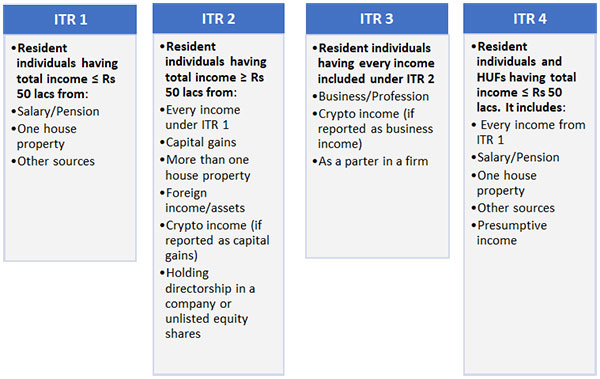
As mentioned above, taxpayers with income from salary, property, capital gains, foreign assets and others are eligible to file ITR 2. Here are the steps to file ITR 2 form for those (salaried individuals) who have earned capital gains for FY 2022-23:
Step #1: First, one has to visit the official website of the Income Tax department and log in with the necessary credentials. Follow this path: e-File> Income Tax Returns> File Income Tax Returns.
Step #2: Select the assessment year 2023-24, choose the status (Individual or HUF) and select the type of form.
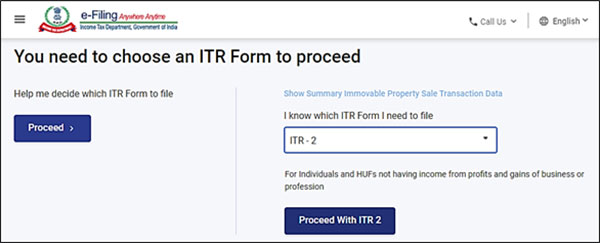
Step #3: After that, select 'Taxable income is more than basic exemption limit' as the reason for ITR filing.
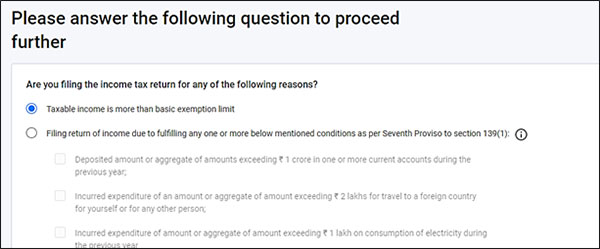
Step #4: The next page will show 5 different types of schedules. Taxpayers have to select 'General-Schedule Part A' and then click on 'Income Schedule >> Schedule Capital Gains' and then choose the type of capital assets from the provided list.
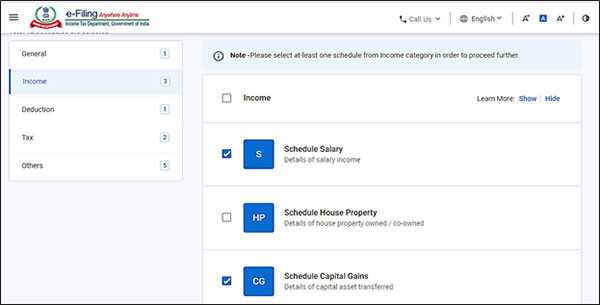
Step #5: Capital gains are of two types - Short-term capital gains and Long-term capital gains, select as applicable in your case. Now under both the categories, a question will arise - 'Whether any amount of unutilized capital gain on the asset transferred during the previous years shown below was deposited in the Capital Gains Accounts Scheme within the due date for that year?'
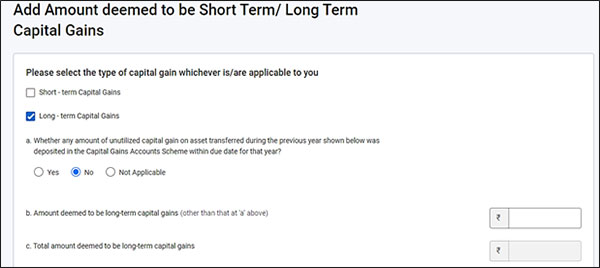
What is Capital Gains Accounts Scheme?
The government has given exemption from capital gains tax if such capital gain is re-invested in certain specified assets within a specific time limit under section 54 to 54GB to promote the reinvestment of the capital gains made on the sale of capital assets by the investor.
The taxpayer has the option of depositing unutilized capital gains in the 'Capital Gains Account' established under the Capital Gains Account Scheme, in which case they will qualify for the same capital gain exemption as if they were reinvested. Taxpayers who get income from capital gains from the sale of any type of property primarily benefit from this system. If you are a salaried individual who has received income from capital gains on the sale/transfer of any investment you shall select the 'No' option for the stated question. Further, the taxpayer needs to provide the consolidated amount obtained from LTCG and STCG, next click on 'Add'.
Do note, for long-term capital gains, individuals have to provide scrip-wise details while they file ITR-2. This will include ISIN, selling price, purchase price, date of different transactions and more.
Step #6: Once the necessary schedules are 'Confirmed', individuals have to review Part B TTI and then tap on 'Preview Return'. Now they have to download the ITR and proceed with the declaration.
Step #7: Taxpayers must provide specified information on the declaration tab before tapping 'Proceed to Validation.' The ITR submission has to be confirmed after validation. Individuals can verify electronically or by sending a physical copy of the signed ITR-V to the Income Tax Department office in Bangalore. Keep in mind that you must validate your ITR within 120 days of filing.
Taxpayers may consider following the aforementioned instructions for a hassle-free ITR 2 capital gains filing experience. Remember that it is crucial to enter accurate data in each section and verify them before submitting the ITR form.
[Read: 7 Tax Planning Checks to Carry Out Before You File ITR For FY 2022-23]
*All the data collated is by PersonalFN Research
MITALI DHOKE is a Research Analyst at PersonalFN. She is an MBA (Finance) and a post-graduate in commerce (M. Com). She focuses primarily on covering articles around mutual funds including NFOs, financial planning and fixed-income products. Mitali holds an overall experience of 4 years in the financial services industry.
She also actively contributes towards content creation for PersonalFN’s social media platforms in the endeavour to educate investors and enhance their financial knowledge.
Disclaimer: Investment in securities market are subject to market risks, read all the related documents carefully before investing.
Disclaimer: This article is for information purposes only and is not meant to influence your investment decisions. It should not be treated as a mutual fund recommendation or advice to make an investment decision.